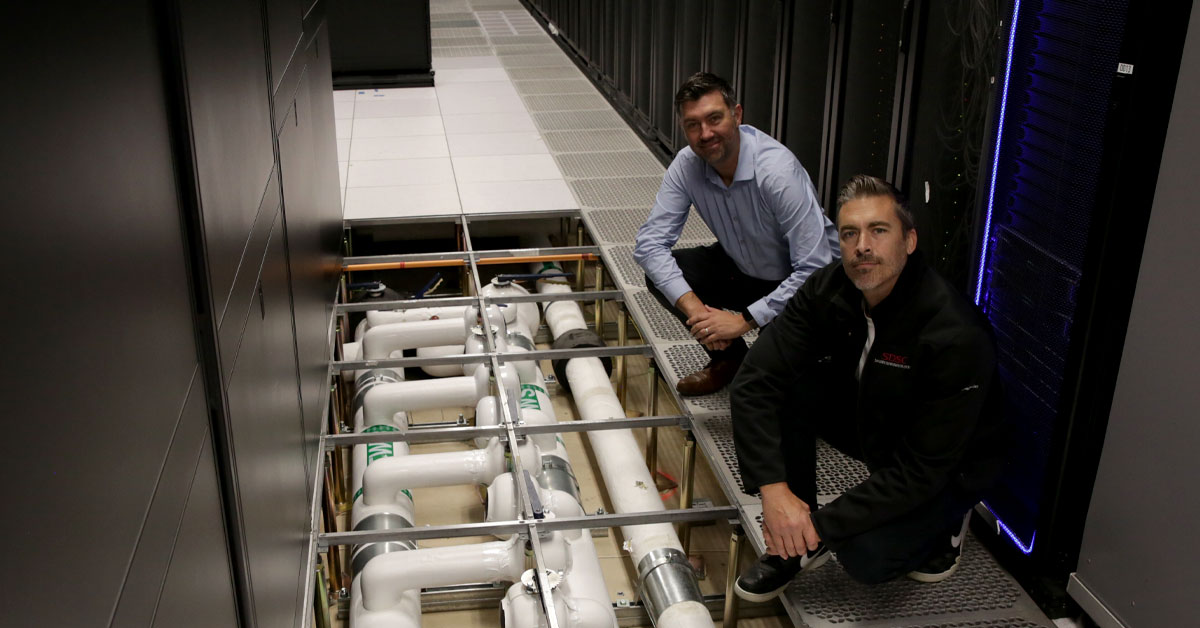News
Liquid Cooling Upgrade Keeps Supercomputers Chill at UC San Diego
Published May 12, 2025
By Kim Mann Bruch

In a significant leap forward for high-performance computing infrastructure at the San Diego Supercomputer Center (SDSC) — part of the School of Computing, Information and Data Sciences at UC San Diego — the Research Data Services (RDS) Division has completed a major upgrade to its liquid cooling system, an essential development for keeping today’s most powerful machines cool, efficient and online.
Supercomputers like the nationally renowned Expanse system at SDSC generate a lot of heat as they run massive amounts of data to create complex simulations necessary for research. If these machines are not cooled properly, overheating can damage their components and reduce their lifespans.
Liquid cooling is an approach that efficiently removes heat from a supercomputer, allowing it to operate at optimal temperatures — essential for maintaining its performance and reliability. Additionally, liquid cooling can help reduce the energy consumption of supercomputers, as it can be more energy-efficient than traditional air-based cooling methods.
The recent upgrade completed at SDSC’s West Data Center, expanded the facility’s liquid distribution system that runs beneath the Data Center's raised floor. Until now, liquid cooling was confined to just two small areas and could only support limited operations. Even Expanse, which introduced liquid from the basement in 2020, was constrained by the original narrow scope of the system.
That is no longer the case.
“Liquid distribution was our limiting factor — now, it’s our strength,” said RDS Director of Infrastructure Brian Balderston, the principal lead for the cooling initiative. “Our biggest constraint for deploying new, large systems has been solved with this upgrade, clearing the way for a new generation of high-performance infrastructure.”
Balderston said that he and SDSC Data Center Manager Thomas Tate worked together to create an ambitious goal for the expansion: make liquid cooling accessible anywhere in the Data Center and significantly increase capacity to meet demands of current and future systems. This newly flexible infrastructure means SDSC can now fully utilize the West Data Center for upcoming computing challenges — particularly as more high-powered systems demand precision cooling solutions.
According to SDSC Director Frank Würthwein, the upgrade quadrupled the liquid cooling capacity from 600 kilowatts (kW) to 2.4 megawatts (MW). For context, 1kW (or 1,000 watts) is equivalent to running a dishwasher for one hour; 1MW (or one million watts) can power roughly 500 to 1,000 households for an hour. The upgrade also laid the groundwork for future capacity improvement – all at a modest cost of $600,000. In contrast, a much larger upgrade that was also considered would have turned the SDSC Auditorium into a 10MW fully liquid cooled facility at a cost of $65 million.
“While we would have loved to build a new 10MW data center, taking the 40-year-old existing Data Center, and refurbishing it was clearly vastly superior in megawatt/mega dollars,” said Würthwein. “Eventually the university will need a larger new data center, but in the meantime, we will optimize what we have to the best of our imagination at the best cost possible.”
Already, several advanced systems — Aware, Cosmos and a new product offering from RDS: AI-ready racks equipped with Rear-Door Heat Exchangers — are taking advantage of the expanded cooling network. Without this upgrade, these cutting-edge systems wouldn’t be operational today.
But SDSC isn’t stopping here. The next phase of improvements is already being planned — focusing on the basement level. The upcoming project will add pumps and heat exchangers to the facility’s process loop, which includes the SDSC cooling tower — further boosting the center’s ability to handle high-performance workloads with state-of-the-art efficiency.
“As supercomputers grow more powerful — and hotter — liquid cooling is becoming the gold standard,” said Würthwein. “With this upgrade led by Brian and his team, SDSC is now better positioned than ever to support the next generation of computational research — from AI and astrophysics modeling to genomics and beyond.”

